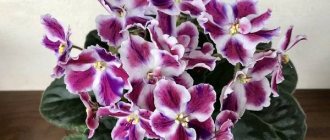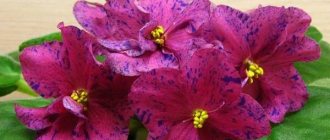Breeders win fans not only with the number of new varieties, but also with their quality. The more beautiful varieties were bred, the more incentive to work further.
Each of the breeders started small; many flower growers, inspired by their results, take the risk of trying themselves in this business. It is interesting to know not only what varieties exist, but also how they are bred . Next, you will learn about which new varieties of violets 2016, 2022, 2022, 2022 were officially presented by flower growers.
Violet PT-Rozalin (T. Pugacheva)
Creator of Saintpaulia
An airy-delicate violet with a neat bush with an exemplary developed rosette and significant size corollas in the form of charmingly opening pinkish pompoms appeared in the registers of domestic violet growing after the completion of the development of breeding experiments with variations of exotic Saintpaulias by the Kursk florist Tatyana Pugacheva.
The variety stands out among the inexhaustible range of varieties of tropical beauties of many breeders in our country with the abbreviation “PT” attached to the names of almost one hundred of its violets.
the development of new varieties of his own selection line extremely pedantically and for a long time , selecting glimpses of extraordinary varietal characteristics from specimens from a variety of options, and also paying special attention to their testing and consolidation.
Since 2013, the presented variety , has been awarded prizes and often the favor of specialists from the judging panels, and has also managed to earn the love of all flower growers.
Taxonomy of the variety
The violet variety is classified as a member of the Saintpaulia genus, which is the most powerful in terms of the enormous volume of its varietal diversity, and is included in the Gesneriev family.
The described violet, in terms of the parameters and volume of the dimensions of the bush is included in the standard format section , and also belongs to the semi-double and double varieties of Saintpaulia in terms of the texture of the placement of the petals within the boundaries of its corollas.
Photo and description of the variety
A varietal violet, provided that it develops in a collection microclimate that is comfortable for it after reaching an adult state, is distinguished by the excellent volume-spatial symmetry of a harmoniously formed bush with a dense texture filled with leaves.
The onset of this phase in the variety occurs almost synchronously with most other beauties of the genus, therefore, to acquire sufficient compactness and configuration of the correct format, the rosette may require a standard period of time.
According to the author's description, Saintpaulia must comply with standard parameters. And many flower growers cultivating the variety at first assume that it will develop somewhat enlarged, albeit very cultivated, rosettes.
But most specimens of the variety only occasionally and only slightly increase their size in comparison with the optimal format of standard representatives of the genus.
IMPORTANT! The growth of violets of this variety is characterized by absolute independence - during the phase of active growth until the final format of the rosette is determined, specimens do not cause any problems to gardeners.
Each Saintpaulia regularly and evenly distributes the leaf plates that replenish the rosette in a predetermined neat order according to the number of tiers appropriate for the variety in order to provide an overall decorative picture of the plant.
Medium-sized violet leaves are distinguished by a quilted texture of a sparkling surface, an elongated oval shape with a smoothly pointed tip and a structurally depressed venation pattern, which stands out against the background of the plate with a delicate network of lateral veins and a salad coloring of the thick central axis.
Along the edges of the leaves there are small, softly smoothed teeth , emphasizing the texture of the delicate openwork waviness of the rosette.
INTERESTING! The structure of the leaf plates has an almost even format, but disturbances in the light regime can change the spatial trajectory of leaf growth: they can take on a slightly wave-like shape or bend towards the flowerpot, creating the volume of a hemisphere. This only adds charm to the violet without violating the decorative integrity of its silhouette.
The color scheme of violet leaves is always created by dark shades of green. The underside of the plates may become covered with a reddish coating , the intensity of which increases with the age of the leaf.
The moment of the first budding of a varietal violet occurs at the classic time for the genus . Saintpaulia begins to bloom with the opening of single, extremely large flowers and almost immediately tries to form modest caps from them, which in the further process of violet maturation acquire a voluminous format due to the large number of huge flowers opening simultaneously.
Varietal violet is valued due to the ethereal pom-pom shape and size of its flowers , which, even at the first opening, delight with their impressive dimensions, as well as the double, less often semi-double, format of the bud creation.
NOTABLE! The “star” petals have abundant waviness of the contour edges, complemented by rich fringe, which, in combination with their large number in the corolla, visually enhances the volume of the flowers and their airy radiance.
The tonal palette of flowers is a soft pink main background of varying degrees of color intensity . The edges of each petal end with a lace braid sprayed in a lilac-pink hue , and their entire surface is delicately painted with a fantasy splash pattern of the same range.
As the fantasy blooms, it may become somewhat lighter.
Sports
Violet is sometimes seen in flower in sporting varieties without edges or fancy spray.
Information about the breeder
Charming violets with large flowers of rich hues were created in the process of breeding development of Saintpaulia varieties by Kursk violet grower Natalya Skornyakova and have the common abbreviation “RM” in their name.
For almost twenty years now, since the beginning of the new century, an experienced master has been breeding his own varietal violets.
The selection line of her Saintpaulias is dedicated to her mother, Raisa Mikhailovna , whose name appears in the branded prefix.
All varieties are different:
- Original decorative configuration of the rims;
- And good repeatability of varietal characteristics.
In the article we will look in more detail at these varieties of violets from the Republic of Moldova: Daisy Harvey, Road to the Stars, Peterhof (N. Skornyakova).
ATTENTION! Specimens of violets of these varieties constantly appear at numerous exhibitions, have earned the approval of specialists in the field of violet growing and are loved by many flower growers.
Care techniques in the home microclimate
In the microclimate of indoor collections, the violet is distinguished by its very unpretentious behavior - the plant responds to the regular and careful implementation of agrotechnical practices typical for the genus by harmonious, measured development and the formation of luxurious flowering caps:
- the plant likes to grow on windows facing west or east , where a suitable balance of volume and light intensity is maintained: windows in the north direction should be equipped with an additional illumination system with diffuse spectrum rays;
- on southern windowsills, violets will need a light curtain in the summer heat.
Diseases and pests
Violet Peruvian lily has good immunity to bacterial infections and most fungal diseases. To avoid the latter, try not to over-water the plants and provide them with regular ventilation. When symptoms of gray rot or bacteriosis appear, plants are treated with fungicides.
The Peruvian lily violet will be saved from pests such as spider mites, aphids, and midges by periodic spraying and watering with infusions of pungently smelling plants. For example, marigolds or calendula.
Extraordinary stages of life
Growing this variety of violet is a real pleasure for gardeners, since it practically does not allow the occurrence of unpleasant surprises that would harm the decorative condition of the plant.
Difficulty of independent growth in indoor collections
The violet of the presented variety is distinguished by its unpretentious character , easy perception of the microclimate of any room, impressive flower parameters and excellent decorativeness.
The standards of the variety oblige Saintpaulia to maintain the fresh texture of the corollas for a long time, and this especially attracts and pleases flower growers.
Other favorable features of the violet’s appearance include:
- the ability to be independent in the formation of rosettes;
- neatness and dense compactness of the leaf bush;
- a luxurious combination of ethereal-delicate corollas in pleasant shades of fantasy coloring and a dark mass of leaf frames;
- chic hats from the first moment of flowering;
- thickened peduncles;
- the number of developing buds.
The nuances of the development of Saintpaulia include:
- the possibility of a wavy texture of sheet plates and the creation of a “hemisphere” effect from a rosette in case of violations of the light regime.
Breeding specifics
Reproduction is possible purely vegetatively:
- children from the sheet;
- layering from mature plants.
The violet variety is distinguished by good fertility and compact children.
Reaction of flowers to the thermal component
Excessive heat when cultivating a plant in the microclimate of a home collection can cause the flowers to fade into a thick pink color until the contour edging and fantasy are almost completely smoothed out.
When kept at elevated temperatures, the variety may completely lose its fantasy color.
To preserve the decorative integrity of the color of flowering specimens, it is recommended to place them in cooler conditions at the time of flowering.
CAREFULLY! You should not allow sharp temperature contrasts and cold drafts in a room with blooming violets - there is a danger of failure of flowering and shedding of buds.
Pedicel format
Varietal violet flowers always form strong, strong-structured peduncles that are capable of holding the heavy corolla caps in an upright position throughout the flowering phase.
Flowering formula
PT-Rosalin, already at the first wave of budding, can form voluminous caps of flowers of enchanting size , the effectiveness of which only intensifies with each subsequent flowering.
Vitality of flowers
The corollas of the Saintpaulia variety are able to maintain a fresh decorative appearance for more than one month , but their color fades somewhat during flowering.
Landing rules
The violet Peruvian lily is propagated using leaf cuttings, children or dividing adult bushes. Large, formed leaves are cut off and placed in a glass of water. With the appearance of roots, it is planted either in a permanent place under a plastic shelter, or in mini-greenhouses for rooting. In the latter option, with the appearance of the baby, the seedling is transferred with the root ball of soil into a flowerpot.
Planting and replanting the violet EK-Peruvian lily is best done in the spring months. This will allow you to get strong plants with good immunity, and speed up the appearance of the first buds. Although it is believed that this variety, like many others, can be planted throughout the year.
Important! Due to the fact that the violet Peruvian lily takes quite a long time to gain strength for the first flowering, and the flower itself only becomes more beautiful over time, it is recommended to divide it no more than once every 2-3 years. But this does not cancel the annual spring replanting of plants. Renewing the soil will help avoid diseases and pest damage.
To grow Peruvian lily violets, select containers with a diameter of about 8-10 cm. Drainage holes are required. A layer of expanded clay or small crushed stone is placed on the bottom. Seedlings are planted in moistened soil and disinfected soil. It can be purchased at a specialized store or prepared independently by mixing garden soil, peat and sand.
Reviews
Natalie. “I love the PT-Rosaline violet and I advise everyone to add this fantastically beautiful variety to their collections! No special worries, it grows easily on its own, and it blooms simply enchantingly: from the first bud it inspires respect for its size, immediately gives you a cap and bewitches you with its pink ruffles and fantasy coating! Just a piece of advice - for brightness of the edge and fantasy, it is better to keep the blooming violet cool.”
Systematics of varieties
In accordance with the official hierarchical rules, the taxonomic periodization of botanical cultures assigns all three violets to:
- Extremely large-scale in terms of the range of varietal diversity that organizes it;
- And the Saintpaulia family, which is part of the Gesneriev family, is rare in its comprehensive picturesqueness of silhouettes.
Varietal specimens of these violets:
- According to the average values of the parameters of their overall bush characteristics, they are in the group of the standard section;
- And according to the characteristics of the size typology of the corollas, they belong to the large-flowered subspecies.
Transfer
Violet Tristan (the photo shows a plant transplant) requires replacing the substrate in the pot twice a year in order to make the most of its nutrients.
The most suitable time for transplantation is autumn (September to November) and spring (February-March). Transplantation is done to allow new roots to grow. The root system of violets ages quickly and therefore needs to be updated. New roots appear only from the fresh part of the trunk, located above the ground. When replanting, old leaves are removed from the trunk and it is placed in the soil. The emergence of new roots will produce fresh leaves and strong flower stalks. Sometimes flowering plants are also replanted. With proper care, this procedure will not harm the violet, it will only slow down the flowering slightly.
When replanting, you should not increase the volume of the pot. Violet variety Tristan feels great in small pots. They stimulate flowering, and large ones promote rapid leaf growth and delay the formation of buds. When replanting, you should ensure good drainage in the pot; violets do not like stagnant water.
Properties
Name
- Original: RS-Zhar Bird
Registration
- Selection: S. Repkina
- Year: 2008
Socket
- Socket type: standard
Flower
- Flower size, up to: 7 cm
- Flower shape: star
- Terry: semi-double
- Main Color: Blue and Yellow
- Color type: multicolor
- Border: none
- Other features: large and always different “torn” flowers, yellow flower color.
Foliage
- foliage color: dark green
- foliage type: simple
- foliage shape: round, quilted
- leaf edge: jagged edge
Photo
RS-Zh a r Pt i tsa, S. R e pkina, photo by I. Polishchuk:
RS-Firebird, RS-Repkina. Photo by Svetlana Sazykina:
RS-Firebird, S. Repkina, photo by T. Lysikova (sport flowering option, no yellow and very little white)
Correct flowering:











